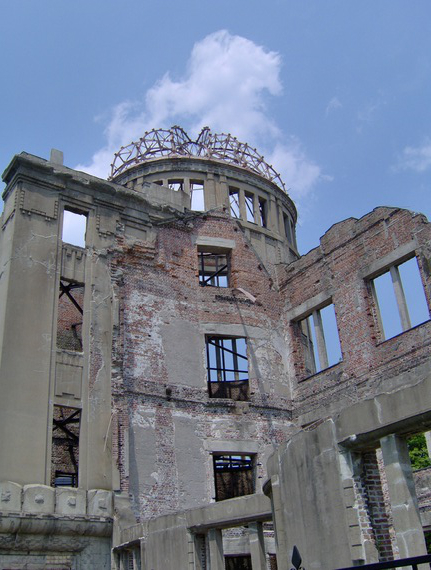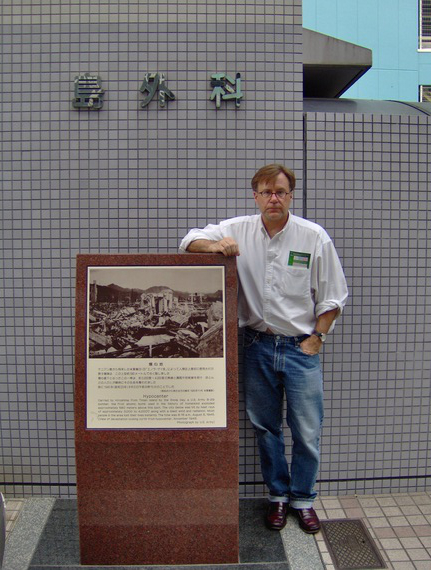(Genbaku Dome. Photo: Jim Clash)
With a different draft of history the events of Aug. 6, 1945, in Hiroshima may have been avoided, and the uranium genie that killed tens of thousands of people in a split-second might have stayed in its bottle. But that wasn't in fate's cards, and once the thing was out it wreaked havoc again just three days later in Nagasaki.
That span of 75 hours is the only time nuclear weapons have been used in war. But the seeds of greater devastation already were hopelessly scattered. Countless more civilians died of radiation sickness in the decades to come, and huge nuclear weapons stockpiles several times as potent as the Hiroshima and Nagasaki bombs were amassed by the superpowers during the Cold War.
I was born in Japan but moved stateside when I was just four. My father was stationed with the U.S. Army at Camp Drake during the post-WWII occupation, managing the PX (Post Exchange) where American servicemen shopped. I don't remember much other than Mt. Fuji towering majestically when the weather was nice.
Later, as a college student, I minored in physics so a trip to Hiroshima was something that popped up on my radar screen.
Before making a pilgrimage to my homeland, though, I visited Trinity, New Mexico, site of the Manhattan Project's first atomic bomb test. Twice a year, on the first Saturday of April and October, the U.S. government opens to the public Trinity via a caravan of cars led by authorities from nearby Alamagordo.
After making the 85-mile drive into the desert, I was immediately intrigued by the mix of people inspecting what's left of the tower upon which the bomb had been detonated - and the green-glass earth called Trinitite fused by 10-million-degree heat from the blast.
Some tourists seemed clueless, as if they were bused in from Disney World. Others had a serious, inquisitive demeanor. A Ukrainian metallurgist told me he had wanted to visit Trinity since childhood. Asked if he felt any irony standing alongside an American after decades of nuclear arms buildup, he flatly said no. "It was only political. People are the same everywhere, I think."
On my ANA flight over to Japan, I thought about that. Are we all the same everywhere? How would I feel at the place where all those Japanese had been incinerated by my own country?
Before making my way to Hiroshima, I visited Kyoto, Japan's most sacred city, in transition from quaint temples to new office and condominium high-rises; climbed Mt. Fuji, Japan's highest and most sacred peak at 12,388 feet; and visited Camp Drake, in the center of Asaka where my dad had worked, now just a fenced-in deserted plot of overgrown brush peppered with dilapidated U.S. government buildings.
I then boarded a Shinkansen "bullet" train for the four-hour trip southwest to Hiroshima. The town is totally rebuilt with few outward signs of what had happened other than the well-manicured Hiroshima Peace Memorial Park and the Genbaku Dome, still in its original bombed-out condition.
Inside the park is a museum, akin to the Holocaust Museum in Washington, DC, with graphic reminders of the horrors of what had happened. On display are scorched watches and clocks that had stopped at exactly 8:16 a.m., the time of the blast; dark shadows of humans vaporized against grey brick walls; and unspeakable photos of human suffering.
I felt slightly nauseated and, being the only American there, tremendously self-conscious. But the Japanese smiled, were incredibly polite as is their nature. I could detect no outward hostility. I smiled back, sheepishly, but I sure felt guilty inside.
The bomb, the equivalent of over 12,000 tons of TNT, had been detonated 1,900 feet above Hiroshima for maximum damage by its blast wave. The most dangerous place was what's called the "hypocenter," the area directly beneath the explosion.
Most tourists assume the mangled dome is the hypocenter. Actually, it's the rebuilt Shima-geka-naika hospital a few hundred yards away. Before leaving the city, I wanted to go there and meditate. It's not advertised and it is not easy to find. Even my Japanese companion did not know about it.
(Shima Hospital hypocenter today. Photo courtesy of Jim Clash)
Once there, I stood looking straight up toward where the unimaginable forces of nature were unleashed 69 years ago, wondering what it must have been like for the 80 or so in the hospital that day. They were vaporized instantly, of course -- mercifully -- before they knew what had happened.
After saying a prayer I left, shaking my head, vowing to delve more into why we had used the bombs in the first place. When I interviewed physicist Edward Teller before his death, he was conflicted. "I did not know what to do at the time," said the man who worked on the atom bomb at Los Alamos and later was credited as father of the hydrogen bomb. "I am very sorry now that I did not make the recommendation I should have."
"There was a way to act that would clearly have been better," he continued. "We could have told [the Japanese] what it was, done a demonstration 20,000 feet over Tokyo Harbor. But perhaps if no one had been hurt, the whole thing wouldn't have been taken seriously. I don't want this to be true, but maybe it is."
I guess we will never know, will we? Let's all just agree on this: We will make sure that such nuclear aggression never happens again, anywhere.
Jim Clash, an adventure journalist, is author of "The Right Stuff: Interviews With Icons of the 1960s" (AskMen, 2012) and "Forbes To The Limits" (Wiley, 2003).

